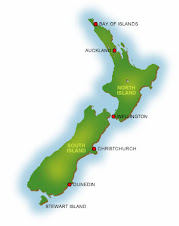June started off with a lot of hard work on my thesis. On my typical 8:30-19:00 day I would write between 5-10 pages. I thought this was great, but my supervisor, Mark Gahegan, was starting to get concerned with the overall document length, which was quickly approaching 200 pages. After discussions with Mark and my friend Alex who helped me edit the thesis, I was able to cut the material back substantially and tighten the arguments up. In the end, the body of my thesis weighed in at 155 pages. It was a huge relief turning it into (and even more so, getting it back from) the University Bindery at the end of the month. While all this hectic writing, editing, and publishing was taking place, I made sure to take brakes over the weekend so I would not completely lose my sanity. Sometimes the breaks were short allowing me to get out for an hour-long run or meander through the local park. At other times the breaks were full scale exoduses from the city, usually a retreat south in search of rapids and the rejuvenation that only water can bring.
Mark Gahegan, Jan Lindsay (my supervisors), and I
John Rehm is probably one of the coolest blokes I have ever met. This sage architect and Rotarian from the Western Springs club, is also an avid hunter and outdoorsman. Naturally we have a lot in common. John invited me out to go duck hunting with him and his dog, Ruby, on Saturday, June 12, in the farm country just north of Auckland. We set up our decoys and waited till sunset. As the ducks would come in to land we would squeeze off our shots and Ruby would retrieve them upon command. By the end of the evening we had three beautiful paradise ducks and one mallard. I took a mallard and paradise duck home and cooked them up with my Czech friends Lada and Patricia. We used a recipe involving bacon, onions, and red wine. Man, were those ducks delicious!
 Following the day out duck hunting, four friends from the canoe club and I drove down to Otorohanga to kayak the Mokau River. It had been raining for days prior so the river was very high and pushy. Interestingly, the high water made the hard class IV rapids easier to run as long as you were online. Little Aratiatia, a hundred meters of whitewater mayhem, was especially frightening, but we all lined it up perfectly and styled the rapid. In the final section of the river we passed through some awesome limestone topography and saw an abundance of wild goats munching away at the local hills. The Mokau was probably one of the most challenging and rewarding rivers I have ever taken on.
Following the day out duck hunting, four friends from the canoe club and I drove down to Otorohanga to kayak the Mokau River. It had been raining for days prior so the river was very high and pushy. Interestingly, the high water made the hard class IV rapids easier to run as long as you were online. Little Aratiatia, a hundred meters of whitewater mayhem, was especially frightening, but we all lined it up perfectly and styled the rapid. In the final section of the river we passed through some awesome limestone topography and saw an abundance of wild goats munching away at the local hills. The Mokau was probably one of the most challenging and rewarding rivers I have ever taken on.Over the next week, I spent a lot of time in the evenings (nights?) hanging out with my friends from university and watching the world cup soccer games. This was the first year in decades that the All Whites (NZ National team) had qualified for the tournament and the country was ecstatic. Considering their underdog status, the All Whites did surprisingly well and had the distinction of being the only team to go undefeated in the tournament (they drew every match).
My last two weeks in New Zealand were awash with thesis presentations. First off was a required presentation at the School of Environment, which I was pleased many of my peers came out to support me in. Next up was a presentation to the DEVORA (Auckland volcanology) group. Finally, on June 30th came the long awaited official presentation to the Auckland Regional Council (ARC) and the Auckland Civil Defense and Emergency Management Group (CDEM). More than thirty people were in attendance for my presentation, a turnout I was very pleased with. (To see the presentation slides click here.) The feedback I got was very positive. Two days later, on the 2nd of July I picked ten copies of my thesis up from the bindery and went around town distributing them. Two copies were submitted to the university for evaluation, two to my supervisors, two I kept, and the others went out to the individuals and organizations (like the ARC and CDEM) whom I had worked for and with. I sincerely hope that my thesis will be of use in assisting Auckland to better understand their volcanic risks and prepare for an evacuation if and when the need arises.

My year as a Rotary Ambassadorial Scholar in New Zealand has been fantastic. I would like to extend a big thank you to all my Rotarians, friends, and family who made this such a great experience for me. Though it may be a few years before I have the opportunity to return to New Zealand I have you all in my heart and move forward with a wealth of knowledge, insight, and inspiration that I gained over the past year. If you are interested in continuing to follow on with my adventures feel free to visit my new blog “On the Move.”





















